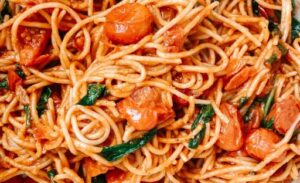Craving an authentic taste of traditional Italian cuisine? Look no further than tonnarelli, the extraordinary pasta that transforms simple ingredients into a culinary masterpiece.
This guide will take you on a delectable journey through the world of tonnarelli, revealing its rich history, unique characteristics, and how you can create this mouthwatering pasta right in your own kitchen.

What Makes Tonnarelli Special?
Tonnarelli, often referred to as ‘squared spaghetti,’ is a beloved pasta variety originating from the heart of central Italy, particularly the regions of Lazio and Abruzzo. Unlike traditional round spaghetti, tonnarelli boasts a distinctive square cross-section that sets it apart in both texture and appearance.
The History and Origins of Tonnarelli
The story of tonnarelli begins in the rustic kitchens of central Italian households, where home cooks transformed simple ingredients into extraordinary meals. Traditionally made by hand using a special tool called a chitarra (guitar), this pasta represents centuries of culinary craftsmanship.

Ingredients and Characteristics of Tonnarelli
Key Features
- Square-shaped cross-section
- Made primarily from durum wheat semolina flour
- Typically egg-based pasta
- Medium thickness
- Excellent for capturing rich sauces
How to Prepare Tonnarelli at Home: A Comprehensive Guide
Ingredients:
- 2 cups semolina flour
- 3 large eggs
- Pinch of salt
- Optional: 1 tablespoon olive oil
Equipment:
- Large mixing bowl
- Pasta roller or chitarra
- Clean work surface
- Fork or whisk
- Pasta cutter or knife
Detailed Preparation Steps
Step 1: Prepare the Dough
- Create a flour mountain on your work surface
- Make a well in the center
- Crack eggs into the well
- Add salt and olive oil
- Gradually incorporate flour into eggs using a fork
Step 2: Knead the Dough
- Knead for 10-15 minutes until smooth and elastic
- Wrap in plastic wrap
- Allow to rest at room temperature for half an hour.
Step 3: Roll and Cut
- Divide dough into smaller portions
- Roll each portion thin using a pasta machine
- Use a chitarra or pasta cutter to create square-shaped noodles
Perfect Sauce Pairings for Tonnarelli
Traditional Roman Recipes
- Cacio e Pepe: Sauce made with cheese and black pepper
- Carbonara: Egg, cheese, and pancetta
- Amatriciana: Tomato and guanciale sauce
Cooking Tips for Perfect Tonnarelli
Pro Techniques
- Cook in generously salted boiling water
- Al dente is key (usually 3-4 minutes)
- Reserve pasta water for sauce consistency
- Finish cooking pasta in the sauce
Nutritional Information
Nutritional Breakdown (Per 100g)
- Calories: 350-380
- Protein: 12-14g
- Carbohydrates: 65-70g
- Fat: 3-5g
Storage and Preservation
Fresh Tonnarelli
- Refrigerate up to 2 days
- Freeze for up to 1 month
- Store in airtight container
Common Mistakes to Avoid
- Overworking the dough
- Not letting dough rest
- Cooking too long
- Skipping salt in water
- Rinsing pasta after cooking
Frequently Asked Questions
What is the difference between tonnarelli and regular spaghetti?
Tonnarelli differs from regular spaghetti in its square cross-section, created using a special tool called a chitarra. While spaghetti is round, tonnarelli has a unique, angular shape that helps it better hold sauces and provides a different texture when eating.
Can I make tonnarelli without a chitarra?
Yes! You can use:
- Pasta machine with a square-cut attachment
- Sharp knife to manually cut square-shaped noodles
- Specialized pasta cutter
- Rolling pin and precise cutting techniques
Is tonnarelli difficult for beginners to make?
While it requires some practice, tonnarelli is manageable for home cooks with basic pasta-making skills. Start with simple techniques, be patient with yourself, and don’t be discouraged by initial imperfections.
What flour works best for tonnarelli?
Semolina flour is ideal. It provides:
- Authentic taste
- Proper texture
- Better pasta structure
- Traditional Italian preparation method
How long can I store homemade tonnarelli?
Storage options:
- Fresh (refrigerated): 2 days
- Dried and stored in airtight container: 1 week
- Frozen: Up to 1 month
What are the most traditional sauces for tonnarelli?
Classic Roman sauces include:
- Cacio e Pepe
- Carbonara
- Amatriciana
- Gricia
Is tonnarelli gluten-free?
Traditional tonnarelli is not gluten-free as it’s made with wheat flour. For gluten-free alternatives, use:
- Gluten-free semolina
- Rice flour
- Corn flour
- Specialized gluten-free pasta flour blends
Can I use a food processor to make tonnarelli dough?
While possible, traditional method is recommended:
- Hand mixing allows better dough feel
- Helps develop gluten structure
- Provides more control over consistency
- Connects you to traditional cooking methods
What’s the ideal thickness for tonnarelli?
Aim for:
- 2-3 mm thickness
- Consistent width
- Even square shape
- Thin enough to cook quickly
- Thick enough to maintain structure
Are there regional variations of tonnarelli?
Yes! Slight variations exist in:
- Lazio region (traditional)
- Abruzzo region
- Different family recipes
- Local ingredient preferences
Enjoy the cooking journey!
